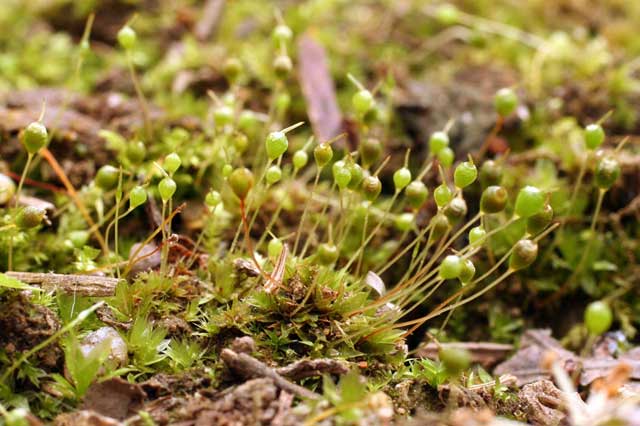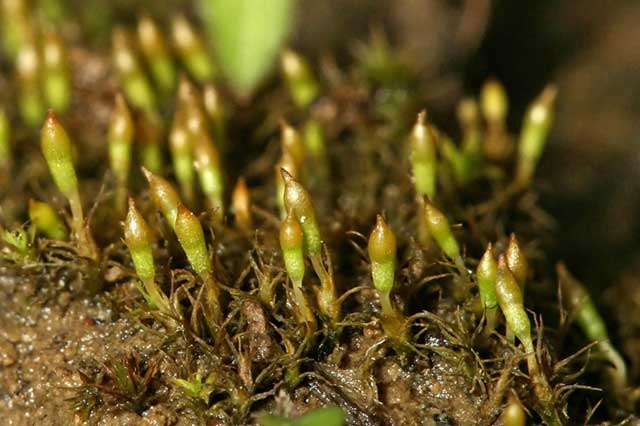 |
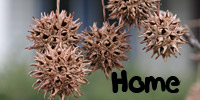 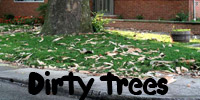 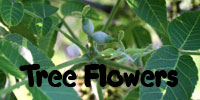 |
A leafy liverwort and its gemmae. Diplophyllum apiculatum Deep Woods Preserve, Hocking County, Ohio. December 27, 2008 Along with the much more numerous mosses and
the much less numerous hornworts, liverworts are a type of bryophyte.
Bryophytes are little plants that are usually described as
"non-vascular" because they lack the specialized plumbing
--water-carrying xylem and food-carrying phloem --that characterizes
all the other true plants. Compared to mosses, most liverworts have more
intricate leaves, but by contrast the liverwort spore-producing stage
of the life cycle is simpler and more short-lived
than the corresponding sporophyte of mosses.
Mixed with mosses on a moist shaded sandstone ledge in a hardwood forest in southern Ohio is a lovely little leafy liverwort Diplophyllum apiculatum (family Scapaniaceae). Somewhat flattened, it has deeply two-lobed leaves that spread out in two rows on opposite sides of a horizontal stem, and these leaves are "conduplicate," i,.e, the rear edge is folded underneath and extends forward.  Diplophyllum apiculatum, approx. 25X microscope view (original). 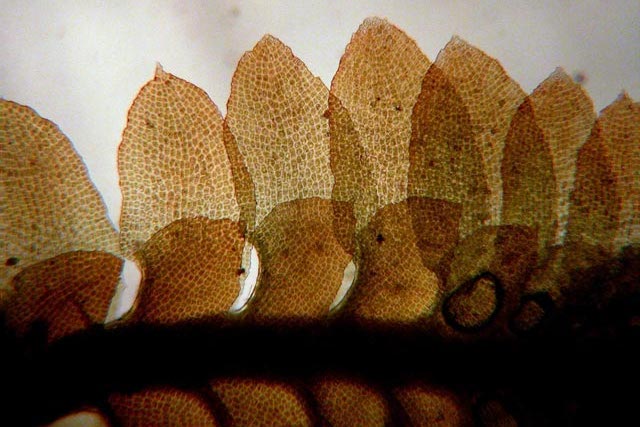 Diplophyllum apiculatum, approx. 40X microscope view (original)
Diplophyllum, like many plants, can
reproduce in two ways: (1) sexually through an intricate process
involving spores and eggs and sperm, and (2) asexually,
wherein a plant produces exact copies of itself. The asexual
reproductive structures of this liverwort are small 1-2 celled "gemmae"
produced abundantly at the tips of many branches. Diplophyllum gemmae are
distinctively angular.
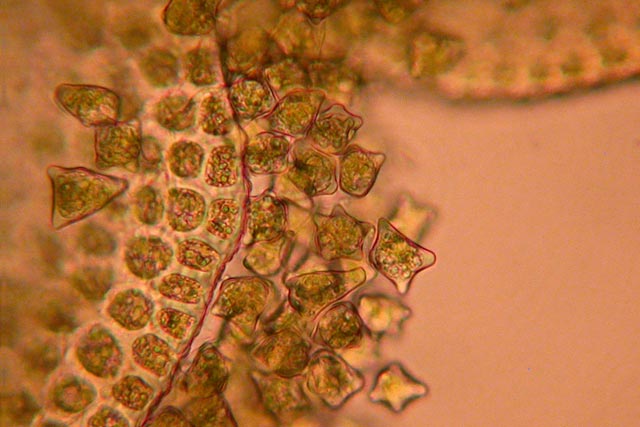 Diplophyllum apiculatum gemmae, approx. 400X microscope view (original) Air freshener is not very precise botanically! This air freshener says on it that
it's a "Royal Pine" freshener. But the conifer pictured on the package
has single (not bundled) needles. That feature, together with
the pendant (drooping) cones indicates the picture is actually a
spruce (genus Picea, family Pinaceae). Moreover, spruce
generally smells like cat urine, and pine is not a whole lot better,
being faintly turpentine-like. The best-smelling conifer is fir (genus Abies, also in the Pinaceae).
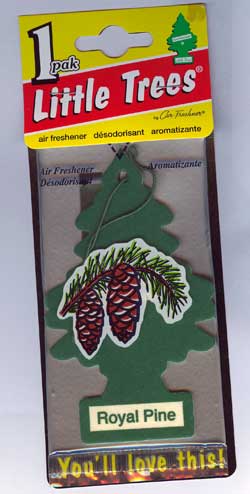 Air freshener with an identity crisis! (Gas station shop in Marion, Ohio.) Butternut Walnut Hazelnut Deep Woods Preserve, Hocking County, OH December 27, 2008 Butternut (Juglans cinerea,
family Juglandaceae) is a beloved hardwood tree that is becoming scarce
throughout much of its range because of a fungus disease that causes
twig and stem cankers that eventually kill the tree. Sometimes called
"white walnut," butternut is a close relative of black walnut,
which is very common. In the winter, trees can be identified by their
twigs. Juglans twigs in general are distinctively stout, with a prominent terminal bud and monkey-face leaf scars.
Twigs of two Juglans species. Left: butternut (J. cinerea). Right: black walnut (J. nigra). How can you tell the two species apart by their twigs? Two main ways: (1) the terminal bud of butterut is proportionally longer than that of black walnut, and (2) the upper edge of the butternut leaf scar has a velvety moustache-like ridge that is lacking on black walnut. 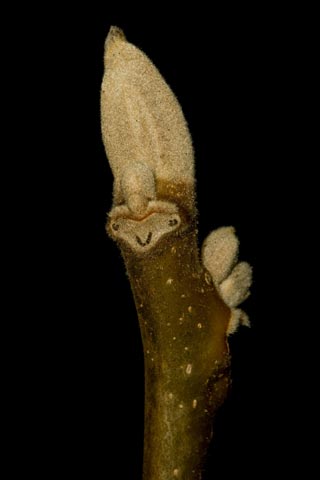 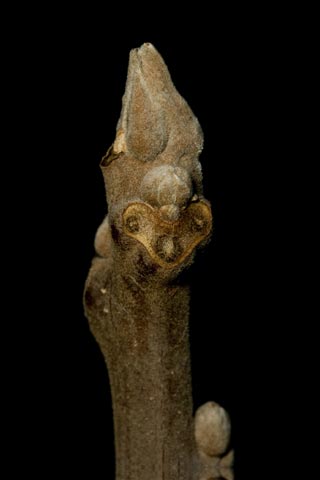 Another intriguing Juglans twig
feature involves the pith (the softer cylinder in the center of the
twig,composed of a different cell type than the woody xylem that
comprises most of the twig). After making a longitudinal section
with a razor blade, you can see the pith is chambered, i.e.,
hollow with cross-partitions.
Contrary to what you might expect knowing that butternut wood is much lighter colored than black walnut, butternut pith is substantially darker! 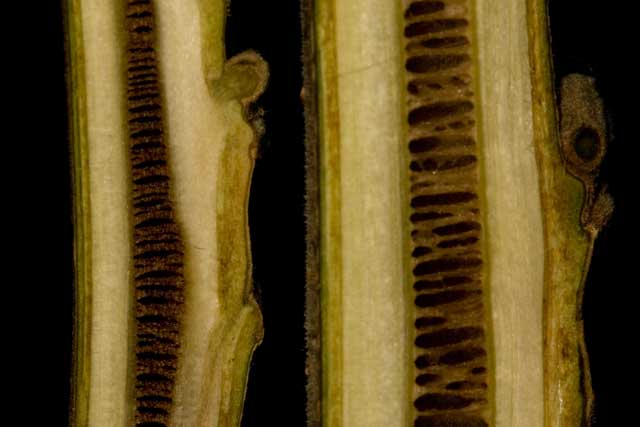 Chambered pith of two Juglans species. Left: butternut (J. cinerea). Right: black walnut (J. nigra). Another woody plant that is distinctive in the winter, if by chance it has some persistent fruits, is American hazel (Corylus americana, family Corylaceae). The typically paired nuts look like big-lipped talking heads facing away from each other, maybe.
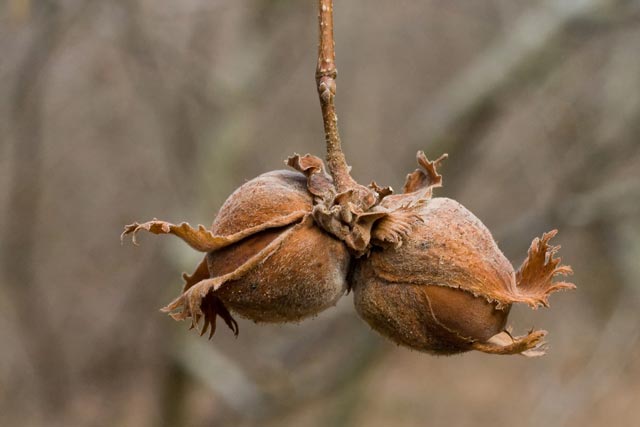 Fruits of American hazel. Deep Woods Preserve, Hocking County, OH. Desember 27, 2008. Honey-locust et al. addition to "Dirty Trees" and Norway maple addition to "Tree Flowers"  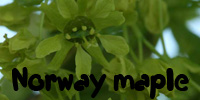 Ephemeral Mosses (originally published in OBELISK, the newsletter of the Ohio Moss and Lichen Association ) www.ohiomosslichen.org Some of the most intriguing mosses are like pixies: small, cute, and appearing for a short time only. Ephemeral mosses tend to appear on disturbed open ground. Farm fields and moist spots in paths through open woods are good places to look for them. You need to get on your knees and keep the hand lens busy. Most or all of them are acrocarps, also called “cushion mosses,” i.e., mosses that consist of separate upright stems bearing sporophytes at their tips. In a manner analogous to the woodland spring wildflowers that burst forth during April before leaf-out shades them, ephemeral mosses generally occur when the potentially overtopping wildflowers or crop plants are absent. For
many species, their timing of occurrence is either
during spring or fall, but not both seasons. One of the most commonly
observed
species, somewhat larger than the other plants mentioned in this
article, is
the “urn moss,” Physcomitrium
pyriforme
(family Funariaceae). It is a spring ephemeral with distinctive broad
leaves
clustered at the base of the plant, and abundantly produced sporophytes
each
with a long seta (stalk) bearing a capsule shaped like a
child’s toy top. P. pyriforme
is known from 51 of
Interestingly, there is another plant, smaller but otherwise nearly identical in appearance that occurs in the same habitats (fallow fields, roadside ditches, etc.) as does Physcomitrium but it most often fruits in fall, and is only rarely seen in spring. This is Tortula (formerly Pottia) truncata (family Pottiaceae). While the Ohio Moss Atlas shows only five county records for this species, it is probably much more common, at least in regions with calcareous soils. The apparent rareness is probably an illusion due not to actual scarcity, but rather because naturalists don’t tend to crawl around on the ground as much in November as they do in May.  Pottia truncata. Marion County. November 5, 2007. Many ephemeral
mosses have sporophytes with setae that are
moderately or very short. Bruchia
flexuosa, (family Bruchiaceae) is an elegant spring-fruiting
species known
from 9 counties. The capsules, which are elevated slightly above the
linear
leaves, have a broadly tapered neck that contributes to an unusual
overall
shape reminiscent of a weather balloon. Like many ephemerals, Bruchia capsules
lack the lid-like operculum
that most mosses have, and thus the capsule ruptures irregularly to
release the
spores.
Bruchia flexuosa. Marion County. May 9, 2008 Several
other ephemeral mosses
have setae so short they are barely discernable, and so the capsules
are immersed in the uppermost leaves. One such species that is fairly
robust (for an ephemeral) grows in dense patches: Astomum
muhlenbergianum (family Pottiaceae). It is one of our few mosses with
involute (upward-curling) leaf margins. The species has been reported
from 12 Ohio counties.
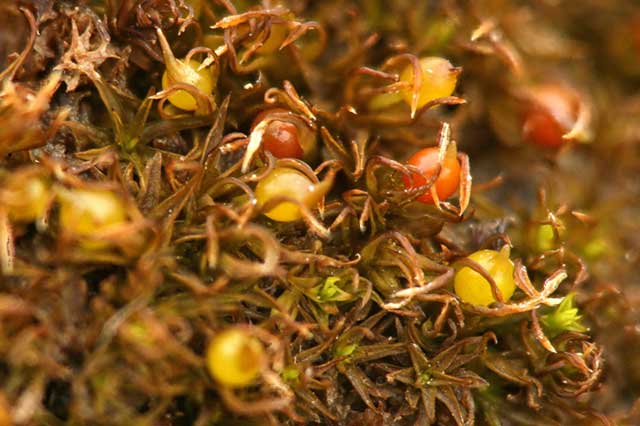 Astomum muhlenbergianum. Marion County. March 27, 2008 A final example, among
the tiniest of the
tiny, is the aptly named genus Ephemerum (family Ephemeraceae), of
which E. crassinervium is our most common species. It occurs, spring or
fall, as scattered plants amidst a thin but sprawling alga-like growth
stage called the protonema, and is known from only 8 counties in the
State.
 Ephemerum crassinerveum. Marion County. November 11, 2007. Some
other ephemeral genera to look for are Phascum
(Pottiaceae), Aphanorregma (Funariaceae), Pleuridium
(Ditricaceae), and Micromitrium
(a genus very similar to Ephemerum, also in the Ephemeraceae). The
“pixies” are fun to hunt, and seem to be a
strikingly
under-reported component of our moss flora. By looking closely at the
ground at odd times of the year in places which seem quite
unexceptional, it’s possible to meet some truly remarkable
plants.
We took a trip to the sea, but we got there late! (400 million years late) Caesar Creek Lake State Park, Warren County, Ohio During the upper
Ordovician Period of the Paleozoic Era, southwestern Ohio was covered
by a shallow sea. Limestones and shales from this area and adjacent
portions of Indiana and Kentucky are extraordinarily rich in fossils.
One
of the best places to see them is at the spillway for the Caesar Creek
dam. During the late 1970's the U.S. Army Corps of Engineers
built the dam to impound the nearly 3000-acre lake. They also excavated
a spillway to serve as a "safety valve" so that, in case there were
ever a severe flood that could potentially overtop the dam,
damaging the damn dam (sorry) in the process, the water would be
shunted around it. I'm not sure whether there's ever actually
been a
flood that high, unless you
accept creationist explanations for why we see the
remains of sea creatures in
places like this. Here's Google Maps view of the area (if it hasn't
shown up, "refresh" your browser):
("refresh" browser if the map
doesn't appear)
Aerial view of Caesar
Creek
Lake, dam and spillway.
(The spillway is at
the south, bisected
by Clarksville Road.)
The Corps
graciously allows fossil collecting here,
provided that you pick up a free permit and obey a few simple
rules. The area is marked by an interpretive sign.
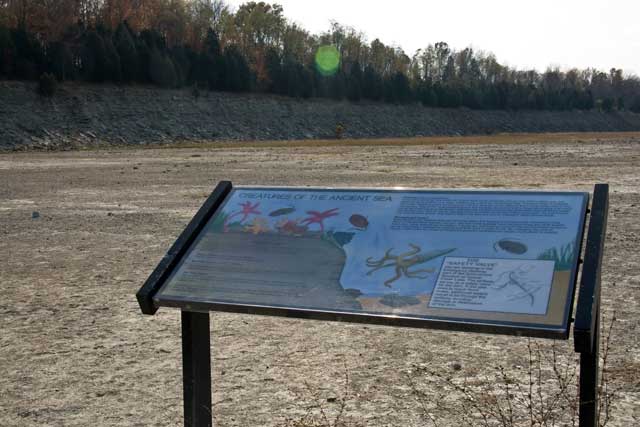 Caesar Creek Lake spillway interpretive sign.  \ \Spillway detail, interpretive sign. The spillway is about
2700 feet long, 500
feet wide, and it exposes, in total, approximately 70 feet of shale
sedimentary rock strata. Fossils are likely to be found anywhere in the
spillway.
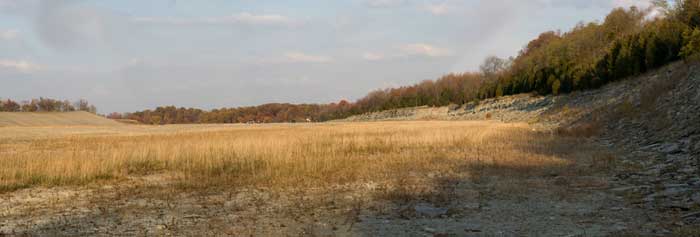 Spillway panorama, taken at west end, facing east-northeast. November 2, 2008. The early Paleozoic
was a time
when shelly marine creatures ruled the world. There are
representatives of the same phyla as contemporary animals, but
with strikingly different groups predominating. The most numerous
shells are those of brachiopods (lamp shells). Superficially, they
resemble clams
(phylum Mollusca) but internally they are very different animals.
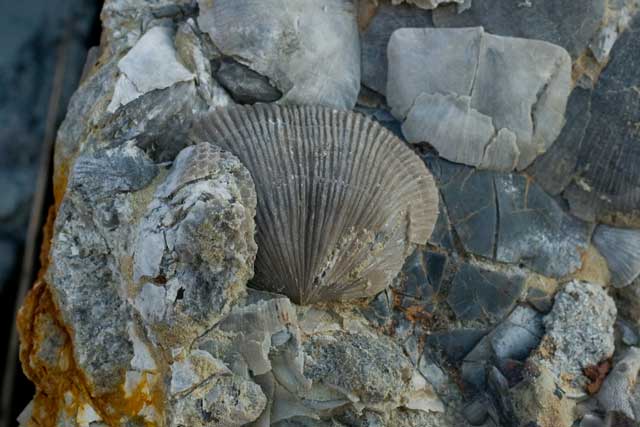 Brachiopod fossils. Caesar Creek, Novemner 2, 2008. Although far less
common than the
brachiopods, there were indeed molluscs in the Ordovician. One group is
gastropods (snails). Here are two specimens.
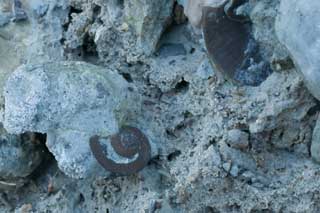 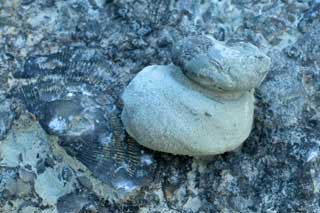 Fossil gastropod molluscs at Caesar Creek. November 2, 2008. Another, more striking,
mollusc was the
cephalopod. This was a member of the same molluscan class as the squid
and octopus of today, but it had an external shell. It must have looked
like an octopus with a dunce cap. In his masterpiece "The Cartoon
History of the Universe," imaginative cartoonist Larry Gonick
depicted a cephalopod, which he calls a "shell-squid" in the following
lighthearted manner.
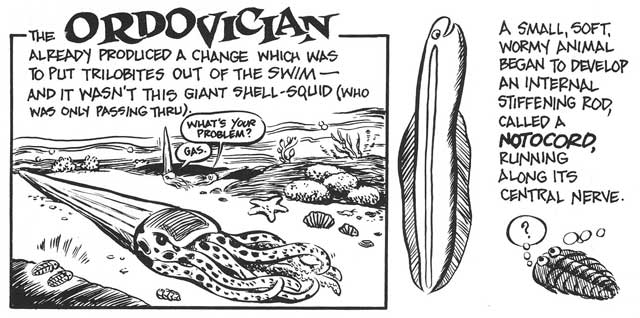 Cephalopods were
chambered internally. This partioning is reflected in some of
the fossils, as shown below.
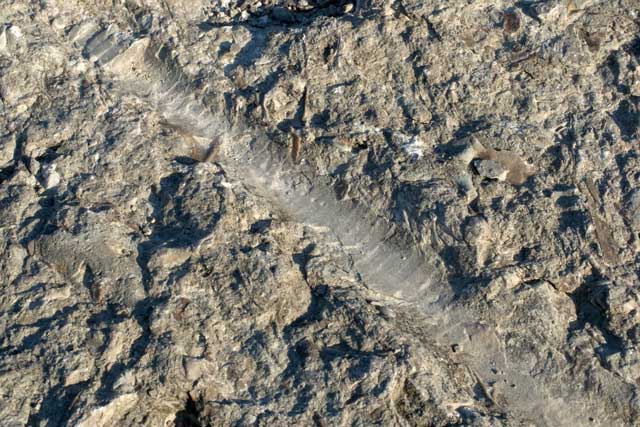 Fossil cephalopod mollusc, Caesar Creek. November 2, 2008. Corals belong to an
animal phylum that is
well represented both in the Paleozoic seas and the present day.
Along with jellyfish (nowadays more correctly termed "sea jellies"
because they are not fish), sea anenomes and hydra, these
animals are all predaceous carnivores who paralyze their prey using
tiny toxin-tipped stinging devices (cnidocytes). Coral animals are
individually small, and live in colonies within a stony (calcareous)
matrix
that they secrete. One of the most conspicuous and intriguing
Ordovician corals is the horn coral, belonging to an extinct order.
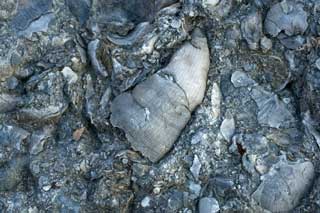 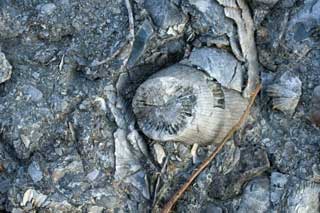 Horn coral fossils. Caesar Creek. November 2, 2008. An expecially common
organism back then,
similar to corals insofar as they are minute colonial animals that
construct limey apartment houses, were the bryozoans (phylum Bryozoa).
Bryozoans still exist today, but they are much less abundant now than
they were back then.
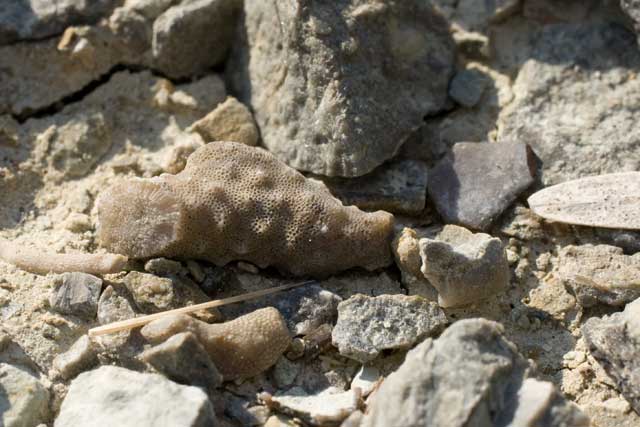 Fossil bryozoan. Caesar Creek. November 2, 2008. The phyum Echinodermata
includes starfish (nowadays
more correctly termed "sea stars" because they are not fish), sea
urchins (which are not urchins), sea lilies (which are
not lilies), and sea cucumbers (which, even though you can buy
them to eat
at the local Asian grocery store, are not cucumbers). Echinoderms
have spiny skin and, as adults, 5-part radial symmetry. Crinoids were
common in the Ordovician seas. Looking like flowers, a crinoids was
anatomically like a starfish on a stalk. Fossil-hunters are
rarely
lucky enough
to see the flowery tops, but screw-like crinoid stems are fairly
frequent.
 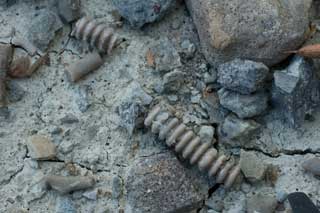 Crinoid fossils at Caesar Creek. November 2, 2008. The Caesar Creek
Visitor's Center, where
you pick up the collecting permit, has a nice scientifically oriented
gift shop that sells nature guides and a "Fossils of Caesar Creek" tee
shirt.
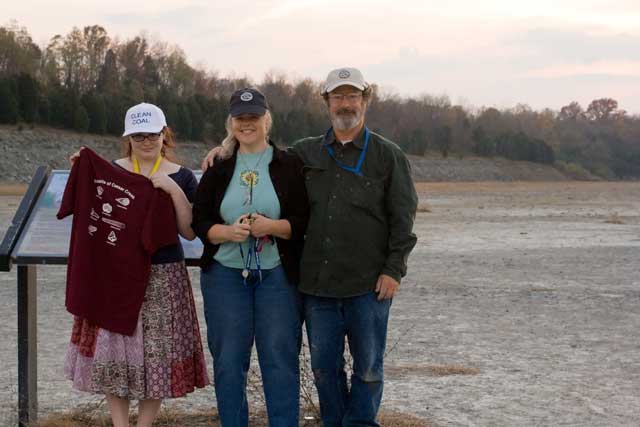 Happy fossil hunters at Caesar Creek. November 2, 2008. |
